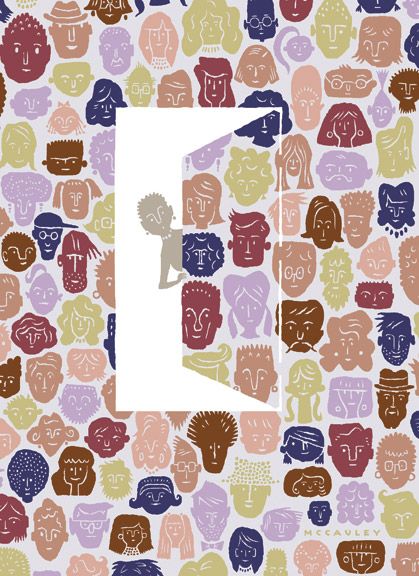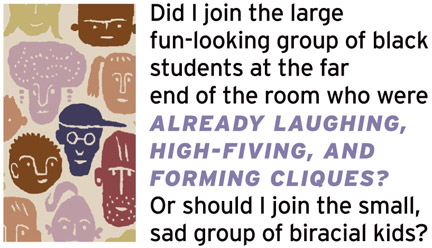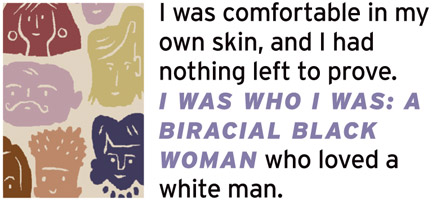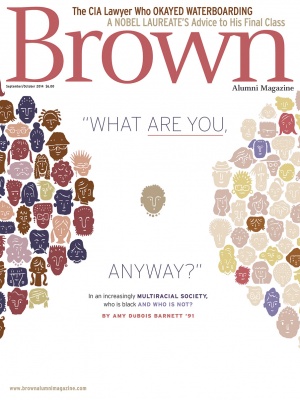It was a muggy day in September 1987. Thanks to the dense New England
humidity of a stubborn Indian summer, most of us pre-freshmen had hung
our crisp new college outfits in the narrow dorm closets and had
retreated into the baggy shorts and long tank tops that all high school
students wore that year.

Brown shoulders abounded as we gathered nervously for our first group
event of the Third World Transition Program, or TWTP, as it was
commonly known. All non-white members of the incoming freshman class
were invited for a four-day orientation that was meant to acclimate us
to our Ivy League surroundings. We were supposed to commune together
and develop bonds so that we would feel comfortable and at home when
the “snowstorm” (our term for the arrival of the Caucasian students)
hit.
Upon arriving at TWTP, my first question had been: What is up with the
name? I’m from New York, not a third world country. Apparently, the
program had been created to appease the mostly African American
students who famously organized a walkout in 1968 to protest their lack
of representation among the classes and faculty. Therefore, even though
the majority of students who gathered under its banner had graduated at
the top of their classes from some of the best high schools in the
Western Hemisphere, the nomenclature was not to be trifled with.
Chastened by the explanation of TWTP’s genesis and shamed by my lack of
knowledge about what it took to make the program a reality, I took my
seat in Andrews Dining Hall next to a cool Indian girl in an all-black
outfit, wearing one enormous earring. In typical teen girl fashion, we
became fast friends in about fifteen minutes, but we were quickly
parted when the program organizers announced that we would be gathering
in ethnicity-based groups. She trotted off to join the Asian students,
and I was left alone to face a difficult choice: Did I join the large
fun-looking group of black students at the far end of the room who were
already laughing, high-fiving, and forming cliques? Or should I join
the small, sad group of biracial kids whose only unifying
characteristic was parents of two different races?
Technically, I belonged with the biracial kids because my mother is
African American, while my father is white and Jewish. But that
characterization did not feel like home to me at all. I had been raised
black, felt black, and had never once called my racial identity into
question. There was no confusion or conflict in my home, either. My dad
had always told me, “It’s simple. I am white and you are black.”
So I made my decision and went off to join the black group. I sat down
in a circle of girls who were complaining that the humidity was jacking
up their straightened hair. My own curls were pulled back into a
ponytail, so I had little to contribute to the conversation. They
looked at me a bit oddly until finally one girl asked, “You sure you’re
in the right group? You look like you’re mixed with something. What are
you, anyway?”
The dreaded question. I’d been asked “What are you?” my whole life as,
apparently, my long nose, tan skin, and curly hair did not immediately
indicate the identity I felt so strongly.
“I’m black, but my dad is white,” I replied.
“Well, aren’t you supposed to be over there?” The girl gestured with
her chin in the direction of the biracial kids, who were in the middle
of choreographing a skit that involved standing on either side of a
rope and pulling back and forth to indicate their racial confusion.
Ugh. Nevertheless, I knew I was too conspicuous to avoid grabbing a
piece of that rope, so off I went. But I left feeling determined that
this would be the last time I would be deemed “not black enough” at
Brown.
I set about my focused overcompensation immediately. I joined most of
the African American groups at Brown, pledged a black sorority, hung
out mostly with black students, and only dated black guys. In the
middle of a Third World Center meeting that somehow devolved into a
heated discussion about relationships, I even made a firm public
declaration that I would never date a white guy.
By my sophomore year I had successfully erased any doubt about my
relative blackness. It had been a challenging process, as the African
American student population at Brown was notoriously judgmental. The
worst possible label a black student could have—and one that we threw
around with relative ease and impunity—was incognegro. An incognegro
was a black student who we did not feel “acted black” enough. Perhaps
that person had too many white friends or, God forbid, hung out with
the “Eurotrash” crowd. Perhaps the person didn’t listen to “black
music” or preferred Wriston Quad frat parties over black Greek step
shows. Maybe the hapless incognegro simply couldn’t shake his or her
lifetime of prep school education and upper-middle-class suburban
upbringing to develop a cultural bilinguality like the rest of us. No
one thought twice when the black salutatorian from Exeter gave a pound
(fist bump, for the uninitiated) to the Phillips Academy lacrosse team
captain and said, “Wassup, bro.”
Yes, I successfully avoided the dreaded incognegro label and was a
fully accepted card-carrying member of Brown’s small but highly
opinionated black community, until the unthinkable happened: I fell in
love with a white student. Before Brown, I’d had an equal number of
white and black boyfriends—a fact I had certainly not made public at
college as I expressed my singular love for the “brothers.” But
sophomore year, I got swept away by a half-Danish student from Vermont.
In other words, I fell for not just a regular white guy, but the
whitest white guy you could possibly imagine. I simply could not help
it; we had a powerful chemistry, and I was head over heels within weeks.
At first, I tried to keep the relationship a secret, but that didn’t
last. We were nineteen-year-olds in love, which necessitated the
requisite hand-holding between classes, sharing meals at the Ratty, and
making out on the Green. Soon, everyone knew that we were a couple, and
the shock reverberated across campus. I expected and received some
ribbing related to my anti-interracial dating comments of a few months
earlier. And I knew the black men of Brown would be less than thrilled
that one of “theirs” had strayed from the fold.

It was during this time that I learned one of the most important lessons that Brown can teach: Being yourself is more important than anything else. And dichotomy is okay, because one extreme does not have to preclude another. I was African American and Jewish. I was a member of a black sorority, yet my best friend was Asian. I loved both hip hop and classic rock. I liked hiking and camping, and I also loved to go clubbing in New York City. And I loved my white boyfriend (and white father, for that matter) but never had any doubt about my black identity.
My boyfriend and I were together long enough that the campus got completely used to seeing us. He would come with me to step shows, and I would play hacky sack on the Green with him and his Deadhead buddies. The more confident and comfortable we were, the more Brown felt like my real home. And I finally realized that I had never been in danger of being labeled an incognegro, because their main distinguishing characteristic wasn’t actually lack of interest in the black community; it was lack of comfort in their own skin.
Sadly, the perils and temptations of junior year proved too much for my boyfriend and me. I went to Paris for the year, while he explored his roots in Denmark. I fell in with a West African and French crowd that never once questioned whether I belonged. My days were spent hanging out in the marché aux puces in front of the Centre Pompidou; at night we would grab a cheap dinner of merguez sandwiches, then ride the Métro to whatever club one of our friends was DJ-ing. It was an idyllic world in which we cared less about race and more about language, culture, and style.
I returned for a restless senior year spent largely—and coincidentally—in the company of Brown students with mixed-race backgrounds. There was my new boyfriend, a black/Welsh Boston native with model good looks and a dichotomous appreciation for the great outdoors and urban life that rivaled my own. I also started hanging out with a black/Swedish student who had been previously snubbed by Brown’s black crowd for her rocker inclinations and her role on the crew team. She was obsessed with a black/Jewish guy with shoulder-length blond dreadlocks, so we spent a considerable amount of time chasing him around the campus.
After graduation, my black/Swedish friend moved to the nation’s biracial capital, San Francisco. I headed back to my hometown, New York City. As I moved through various industries (from finance to fashion to media), I felt ever more secure in my own biracial skin. I still got asked the annoying question that had consistently defined much of my interaction with strangers: “What are you, anyway?” But in the melting pot that is New York City, my answer of “I’m black but my dad is Jewish,” was received with little more than a nod. I had a diversity of friends, none of whom questioned my identity.
A few years passed. I began a relationship with the tall and very brown-skinned black man whom I would eventually marry. At one point, we debated moving to the West Coast and decided to visit my friend in San Francisco. She was now sporting a sleeve of tattoos, a nose ring, and an all-black wardrobe. Her boyfriend’s complexion almost matched her very light toasted-almond tone, but his was the result of having two equally light-skinned black parents.
One day she and I went to grab a coffee together. We talked about how tall my kids would be if I married my boyfriend. “They’ll be huge,” I joked, “but at least no one will ask them what they are. They’ll be brown enough to avoid that nonsense. Your kids might have an issue. They’ll be so light that no one will know that they’re black!”
My friend stopped smiling and peered at me weirdly. “My kids won’t be black. Why would I call them that when they’ll look closer to white?”
“Uh, because they’ll have two black parents,” I replied, thinking that she must be kidding. “You’re half black, therefore you’re black, and your guy has two black parents, so there’s no debate at all there.”
My friend, who had had an admittedly tough time growing up as a tan girl with a Swedish name in a provincial New England town, proceeded to tell me that she didn’t consider herself to be black and that she thought the whole one-drop rule—the historical idea that any person with a trace of black ancestry is black—was just stupid.
“In Brazil,” my friend said, “neither my boyfriend nor me nor you, for that matter, would be considered black. Why should I make my kids take that on when they will clearly have as much white blood, if not more?”

I was shocked and offended. We had a heated discussion, during which I tried to get her to understand that being black had powerful cultural and political connotations that were personally awesome and had greater implications for our country. But her assertion that she “refused to call her [future] kids black” killed our friendship for more than a decade.
This wasn’t just a personal issue for me; it still is a principle of extreme importance to the African American community as we are faced with the diffusion of our collective power by future generations of biracial kids who don’t define themselves as black. While it may seem like a wholly personal and innocuous decision to claim multiple races or to check off the new multiracial category on a census, it’s a decision that affects the government data that help determine what programs and funding are needed to address social inequities. Fewer multiracial or biracial people identifying as black could have devastating consequences.
After I became the editor-in-chief of Ebony magazine, the country’s oldest and largest African American publication, I was part of many discussions about racial identity and black power. In many people’s eyes, my perspective in these conversations was complicated by my own mixed background and by the fact that I was now divorced and in a serious relationship with a white man. But the lesson I learned at Brown has never left me: I’m comfortable in my own skin and in my racial identity. Whom I date still has nothing to do with who I am. Still, when my team at Ebony and I decided to do a special feature on being multiracial in America, I observed a generational divide on the issue of who is black and who is not. Most of the younger people, regardless of their skin tone, contended that multiracial was a valid category for half-black people. For the first time, my views began to feel somewhat anachronistic.
Years later, when I got together with my college friend for the first time since that last disastrous meeting in San Francisco, I found that we had both mellowed when it came to our views on the subject. She now has three gorgeous daughters whose skin color ranges from her oldest, who is a beautiful nut-brown and undeniably black, to her youngest, whose pale skin and blond-streaked sandy curls give her a more multiracial look. While my friend still thinks the American one-drop definition of blackness is ludicrous, she is now more comfortable in the African American community.
And as for me, while I still believe that blackness is as much a political issue as a personal one, I now have many friends who married outside their ethnic group. As their legion of multiracial kids grows up, I can see how racial categorization in the United States will become more and more complicated. For example, my girlfriend’s biracial, blond, dreadlocked college crush eventually married an Asian woman, and they now have twins. What race are those kids? I hold on to the notion that because their dad is black, so are they. Their Asian mom, however, is likely to differ.
The census bureau estimates that by 2050 the United States will be a majority minority country, in large part due to the multiracial children born to the rapidly increasing number of interracial couples. With a country full of people like Tiger Woods, descriptors such as Cablinasian—Woods’s term for his own Caucasian/Black/American Indian/Asian makeup—may eventually eclipse African American. The question “What are you, anyway?” might become as common in a new conversation as “What do you do for a living?”
And my Black/Swedish friend might get the last laugh.
Amy DuBois Barnett, former editor-in-chief of Ebony, is executive editor of a new ESPN website offering commentary about sports and culture for an African American audience. A portion of this essay appeared in The Brown Reader: 50 Writers Remember College Hill.





